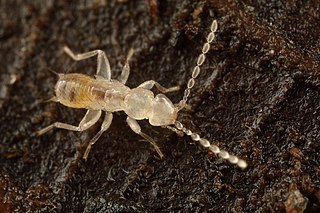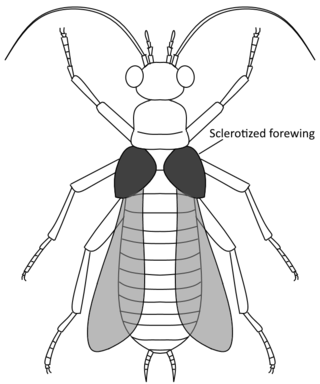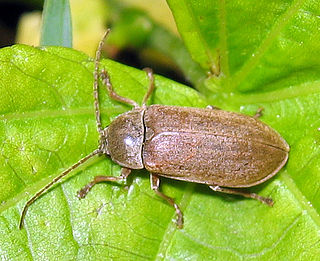
The insect order Zoraptera, commonly known as angel insects, contains small and soft bodied insects with two forms: winged with wings sheddable as in termites, dark and with eyes (compound) and ocelli (simple); or wingless, pale and without eyes or ocelli. They have a characteristic nine-segmented beaded (moniliform) antenna. They have mouthparts adapted for chewing and are mostly found under bark, in dry wood or in leaf litter.

Zorotypus is a genus of angel insects in the family Zorotypidae.

The Elateroidea are a large superfamily of beetles. It contains the familiar click beetles, fireflies, and soldier beetles and their relatives. It consists of about 25,000 species.

Byrrhoidea is a superfamily of beetles belonging to Elateriformia that includes several families which are either aquatic or associated with a semi-aquatic habitat. Other than the superfamily Hydrophiloidea, most of the remaining Polyphagan beetles which are aquatic are in this superfamily.

Nosodendridae is a family of beetles, with less than a hundred species in three extant genera, which are found worldwide. Nosodendron, the largest genus, is found in forests and attracted to yeast generated slime on the wounds of trees, and likely consumes fermented substances as well as fungi and microorganisms. Several additional genera and species are known from the fossil record. Nosodendridae is considered to be an isolated lineage within Polyphaga, being the sister group to the clade containing Staphyliniformia, Bostrichoidea and Cucujiformia.
Spiralizoros silvestrii is a species of angel insect in the family Zorotypidae. It is found in Southern Asia.

The Brachypsectridae are a family of beetles commonly known as the Texas beetles. There are only two extant genera, Brachypsectra and Asiopsectra. Brachypsectra has a cosmopolitan distribution, mostly in arid regions, while Asiopsectra is found in Central Asia and the Middle East.
Spermozoros impolitus is a species of insect in the order Zoraptera.
Spiralizoros cervicornis is a species of insect in the order Zoraptera. It was first found in Malaysia.
Spiralizoros magnicaudelli is a species of insect in the order Zoraptera. It was first found in Malaysia.

Alienopteridae is an extinct family of dictyopterans, known from the Mid-Cretaceous to Eocene. They are noted for their unusual combination of features not found in other dictyopterans.

Dascillidae is a family of beetles within the clade Elateriformia. There are about 100 extant species in 11 genera, which are found worldwide. Dascillidae together with Rhipiceridae form the super family Dascilloidea.

Artematopodidae is a family of soft-bodied plant beetles in the superfamily Elateroidea. They are mostly found in understory forest foliage. The life history of the group is obscure, larvae of the genera Eurypogon and Macropogon likely feed on moss, while the larvae of Artematopus have been fed insect remains. The oldest fossils of the family date to the Middle Jurassic.
Caputoraptor is an extinct genus of insect from the Cenomanian aged Burmese amber containing two species: the type species Caputoraptor elegans, as well as Caputoraptor vidit. It is part of the extinct order Alienoptera. C. elegans is notable for the presence of a scissor like mechanism consisting of a straight edge on the back of the head and corresponding serrated edges on the first thoracic segment, these were initially suggested to be used by the female to grasp the male during mating, but the structure is not sexually dimorphic, so a use to hold prey was subsequently suggested. Its morphology suggests a predatory habit inhabiting shrubs and trees. In 2020 a Caputoraptor elegans nymph was described that was in the process of being predated upon by a Ceratomyrmex hell ant.

Usazoros hubbardi, commonly known as Hubbard's angel insect, is a species of insect in the order Zoraptera. It is native to the tropical and subtropical New World and has expanded its range into the eastern United States, where it lives in piles of sawdust, whereas in the hotter part of its range it lives under the bark of decomposing logs. It was named after the American entomologist Henry Guernsey Hubbard, who discovered the insect in the United States.
Burmese amber is fossil resin dating to the early Late Cretaceous Cenomanian age recovered from deposits in the Hukawng Valley of northern Myanmar. It is known for being one of the most diverse Cretaceous age amber paleobiotas, containing rich arthropod fossils, along with uncommon vertebrate fossils and even rare marine inclusions. A mostly complete list of all taxa described up until 2018 can be found in Ross 2018; its supplement Ross 2019b covers most of 2019.
Burmese amber is fossil resin dating to the early Late Cretaceous Cenomanian age recovered from deposits in the Hukawng Valley of northern Myanmar. It is known for being one of the most diverse Cretaceous age amber paleobiotas, containing rich arthropod fossils, along with uncommon vertebrate fossils and even rare marine inclusions. A mostly complete list of all taxa described up until 2018 can be found in Ross 2018; its supplement Ross 2019b covers most of 2019.
Spiralizoros is a genus of zorapterans in the family Spiralizoridae. There are about eight described species in Spiralizoros. The species of this genus were transferred from the genus Zorotypus as a result of research published in 2020.
This paleoentomology list records new fossil insect taxa that are to be described during the year 2022, as well as notes other significant paleoentomology discoveries and events which occurred during that year.

Chelidurella is a genus of European earwigs, in the family Forficulidae and subfamily Anechurinae, erected by Karl Wilhelm Verhoeff in 1902. The recorded distribution of species is mostly in northern Europe including Britain. The genus name was recently restored by Kirstová et al., who provide a key for identification of males.










